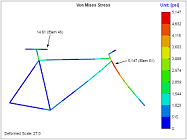2D FEA Validation
This section details the validation for the 2D FEA calculator. Several examples are worked through to determine expected results such as deflections, forces, and stresses. These expected results are then compared to the actual output of the 2D FEA.
Cantilever Beam, Triangular Distributed Force
The standard beam equations for a cantilever beam loaded with a uniform distributed force are given below:
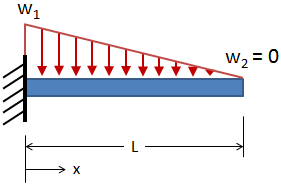
| Max Deflection: | $$ \delta_{max} = {w_1 L^4 \over 30EI} $$ | @ x = L |
| Max Slope: | $$ \theta_{max} = {w_1 L^3 \over 24EI} $$ | @ x = L |
| Max Shear: | $$ V_{max} = +{w_1 L \over 2} $$ | @ x = 0 |
| Max Moment: | $$ M_{max} = -{w_1 L^2 \over 6 } $$ | @ x = 0 |
For the validation case, an Aluminum 6061-T6 beam with a 1 inch diameter circular cross-section and a length of 10 inches will be loaded with a triangular distributed force with a value of 200 lbf/in at the fixed end and 0 lbf/in at the free end. Since the beam is 10 inches long, the total force applied to the beam is 1000 lbf. The inputs are:
For the given inputs, the expected results are:
| Max Deflection: | \( \delta_{max} = 0.1358 \text{ in} \) | @ x = L |
| Max Slope: | \( \theta_{max} = 0.01698 \text{ rad} \) | @ x = L |
| Max Shear: | \( V_{max} = +1000 \text{ lbf} \) | @ x = 0 |
| Max Moment: | \( M_{max} = -3333 \text{ in-lbf} \) | @ x = 0 |
Since distributed forces are applied to the mesh by applying a force to each node (as opposed to the ideal continuum), the results are affected by mesh density. The results converge toward the ideal results as the mesh is refined.
The Free Body Diagrams (FBD) for two different mesh densities are shown below. From the FBDs it can be seen that the forces balance and the beam is in static equilibrium. Since the triangular distributed force is applied at discrete nodes, the moment reaction at the fixed end is not exactly equal to the ideal case, but it does converge to the expected moment as the mesh is refined.
FBD, 30 Elements in Mesh:
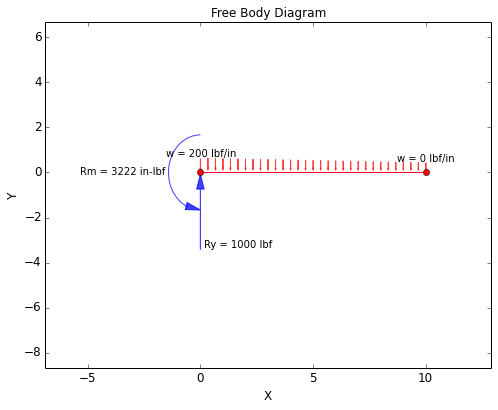
FBD, 50 Elements in Mesh:
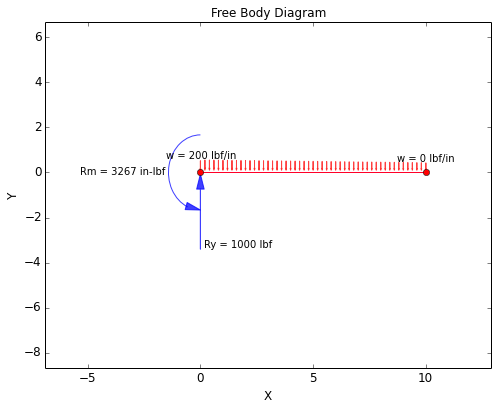
The ideal displacements as compared to the 2D FEA results for different mesh densities are given in the table below:
| Displacement @ x = L | Slope @ x = L | |
|---|---|---|
| Ideal: | 0.1358 in | 0.01698 rad |
| 30 Elements: | 0.1313 in (3.32% error) | 0.01641 rad (3.34% error) |
| 50 Elements: | 0.1331 in (2.00% error) | 0.01664 rad (1.98% error) |
The displacement plots for two different mesh densities are shown below:
Displacement Plots, 30 Elements in Mesh:
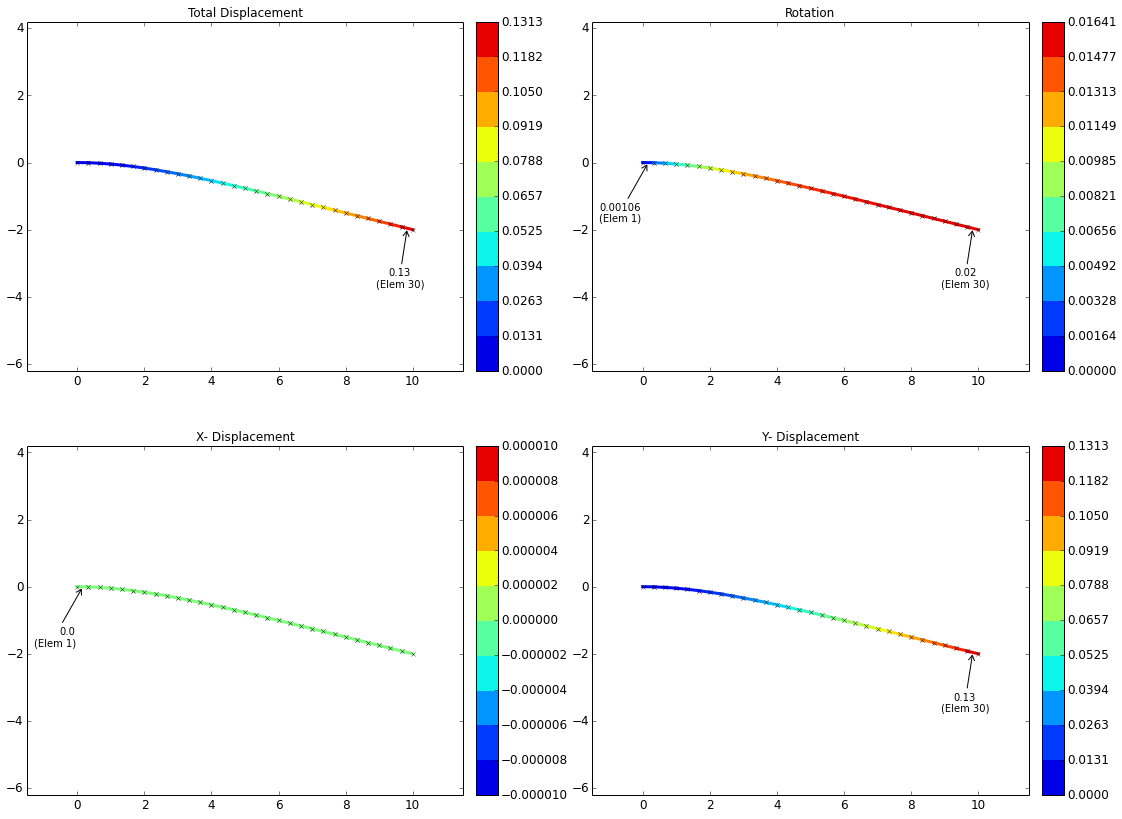
Displacement Plots, 50 Elements in Mesh:

The shear-moment diagrams for the beam are shown below at varying mesh densities. In the ideal case, the peak shear force at x = 0 would be 1000 lbf and the peak moment at x = 0 would be 3333 in-lbf. However, since the results are affected by mesh density for distributed loads, the shear forces and moments are not quite exact although they do converge toward the expected results as the mesh is refined.
The overall trends of the shear-moment diagrams are what would be expected. The shear force decreases parabolically from the fixed end of the beam to the free end. The magnitude of the moment decreases cubically from the fixed end of the beam to the free end.
Shear-Moment Diagram, 30 Elements in Mesh:
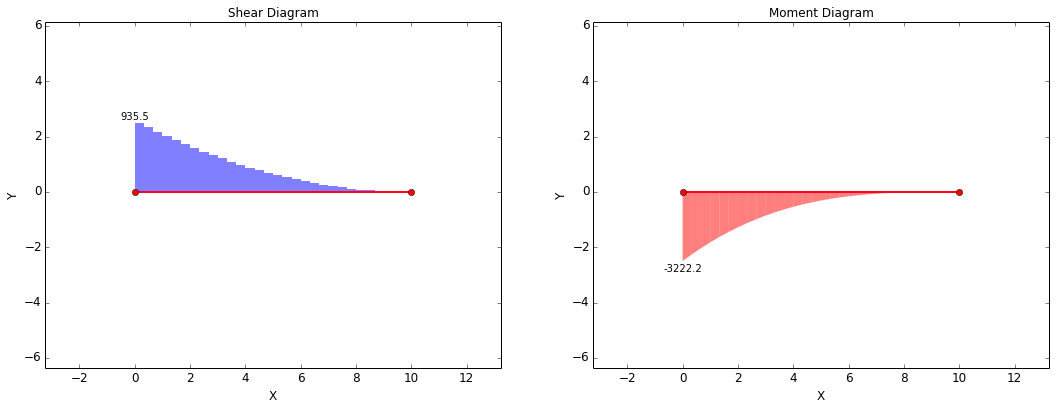
Shear-Moment Diagram, 50 Elements in Mesh:
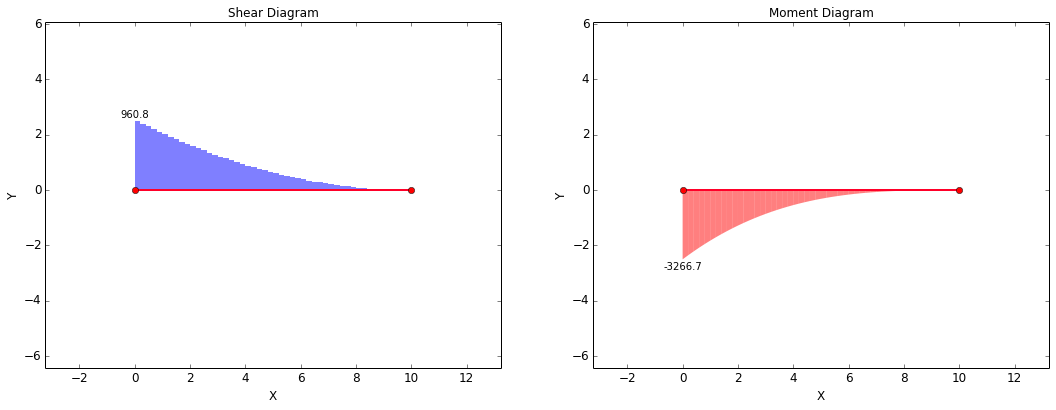
The stresses will be validated at the fixed end of the beam. At this point, the ideal forces are:
| Axial (lbf) | Shear (lbf) | Moment (in-lbf) | |
|---|---|---|---|
| Forces @ x = 0: | $$ F_{ax} = 0 $$ | $$ F_{sh} = 1000 $$ | $$ M = 3333 $$ |
The stresses are calculated using the following equations:
| Axial Stress | Shear Stress | Bending Stress | Von Mises Stress |
|---|---|---|---|
| $$ \sigma_{ax} = {F_{ax} \over A} $$ | $$ \tau_{sh} = {F_{sh} \over A} $$ | $$ \sigma_{b} = {Mc \over I} $$ | $$ \sigma_{vm} = \sqrt{ (\sigma_{ax} + \sigma_{b})^2 + 3\tau_{sh}^2 } $$ |
Based on the equations above, the ideal and calculated stresses at the fixed end are:
| Tensile, \( \sigma_{ax} \) (psi) | Shear, \( \tau_{sh} \) (psi) | Bending, \( \sigma_{b} \) (psi) | Von Mises, \( \sigma_{vm} \) (psi) | |
|---|---|---|---|---|
| Ideal: | $$ 0 $$ | $$ 1273 $$ | $$ 33953 $$ | $$ 34025 $$ |
| 30 Elements: | $$ 0 \text{ (0% error)} $$ | $$ 1191 \text{ (6.46% error)} $$ | $$ 32821 \text{ (3.33% error)} $$ | $$ 32886 \text{ (3.35% error)} $$ |
| 50 Elements: | $$ 0 \text{ (0% error)} $$ | $$ 1223 \text{ (3.95% error)} $$ | $$ 33274 \text{ (2.00% error)} $$ | $$ 33341 \text{ (2.01% error)} $$ |
The stress plots are shown below at varying mesh densities:
Stress Plots, 30 Elements in Mesh:

Stress Plots, 50 Elements in Mesh:

